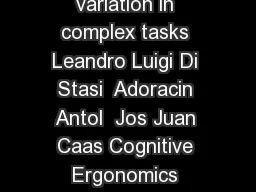

Taking the Wickens multiple resource model as the theoretical framework of reference an experiment was conducted using the Firechief microworld MW was manipulated by changing the task complexity between groups and the amount of training within group ID: 31433
Download Pdf The PPT/PDF document "Main sequence An index for detecting men..." is the property of its rightful owner. Permission is granted to download and print the materials on this web site for personal, non-commercial use only, and to display it on your personal computer provided you do not modify the materials and that you retain all copyright notices contained in the materials. By downloading content from our website, you accept the terms of this agreement.
Mainsequence:AnindexfordetectingmentalworkloadvariationincomplextasksLeandroLuigiDiStasi,AdoraciónAntolí,JoséJuanCañasCognitiveErgonomicsGroup,DepartmentofExperimentalPsychology,UniversityofGranada,Granada18071,SpainHumanTechnologyLab,DepartmentofGeneralPsychology,UniversityofPadua,Padua35131,ItalyarticleinfoArticlehistory:Received17December2009Accepted17January2011Keywords:EyemovementsMicroworldsFatigueTheprimaryaimofthisstudywastovalidatethesaccadicmainsequence,inparticularthepeakvelocity Correspondingauthor.CognitiveErgonomicsGroup,DepartmentofExperi-mentalPsychology,CampusdelaCartujaS/N,UniversityofGranada,Granada18071,Spain.Tel.:34958243767;fax:E-mailaddress:distasi@ugr.es(L.L.DiStasi).Althoughthetermsmentalworkloadcognitiveloadareusedinter-changeably,theyarenotidentical(foradiscussion,seeSwelleretal.,1998Nevertheless,forthepurposesofthispaperwewillusetheexpressionsassynonyms. ContentslistsavailableatAppliedErgonomicsjournalhomepage:www.elsevier.com/locate/apergo 0003-6870/$seefrontmatter AppliedErgonomicsxxx(2011)1 Pleasecitethisarticleinpressas:DiStasi,L.L.,etal.,Mainsequence:Anindexfordetectingmentalworkloadvariationincomplextasks,AppliedErgonomics(2011),doi:10.1016/j.apergo.2011.01.003 rate,electrodermalactivityorelectroencephalographicactivity,seeParasuramanandRizzo,2007)toassessmentalstate.1.1.MainsequenceandmentalworkloadCerebralactivitymeasurements,suchasfunctionalmagneticresonanceimagingorelectroencephalographyprovideanoppor-tunityforamoredirectandsensitiveassessmentofmentalwork-load(RyuandMyung,2005).ThehumaneyesareoutgrowthsofthebrainandareconsideredaspartofthecentralnervoussystemHoar,1982;WilsonandODonnell,1988).Forthisreason,theanalysisofgazeparametersmayserveasagoodindexofmentalstate.Thespeedofsaccadicmovements,forexample,notbeingundervoluntarycontrol(LeighandZee,1999),couldbedirectlysensitivetotheeffectsofvariationsinmentalstate,astheycannotbeaffectedbythepersonsmotivationalstate(Rowlandetal.,2005Intheliterature,eyemovementparametershavealreadybeenusedasindicatorsofattentionalsate(seeforexample:AhlstromandFriedman-Berg,2006;Schleicheretal.,2008;DeyandMann,2010).However,researchershaveoftenfocusedontherelation-shipbetweensaccadicamplitudeandxationdurationmorethanonsaccadedynamics(forexample:Unemaetal.,2005;Graupneretal.,2007;Pannaschetal.,2008Saccadiceyemovementsvaryinamplitude,duration,and(peak)velocity(DodgeandCline,1901;Dodge,1917).Therelationshipbetweenthesethreeparametershasbeencalledthemainsequence,toindicatethatPVandsaccadicdurationincreasesystematicallywiththeamplitude(Bahilletal.,1975).ItisofimportanceforthepurposeofthecurrentstudythatthePVisindependentofthesaccadicdurationsinceitisnotlinkedtoit,apriori,byamathematicaldenition,likesaccadicmeanvelocityisBecker,1989).Recentstudiesinourlaboratoryhavefocusedonanalyzingtheinuenceofparticularmentalstate(i.e.mentalover-load)onthemainsequence,ndinganinverserelationshipbetweentheincreaseofMWandPVvalues(DiStasietal.,2009,2010a,2010bDiStasietal.(2009)evaluatedwhethermeasuresofeyeactivitycorrelatedwithMWanddifferenttypesofriskybehaviorusingaridingsimulationtask.Itwasfoundthatthehigh-riskgrouphadshortersaccadedurationsandhigherPVsthanthelow-riskgroup.OntheMentalWorkloadTest[MWT,seebelow]thehigh-riskgroupscoredsignicantlyhigheronseveraldimensions.Further-more,PVshowedseveralsignicantcorrelationswithMWTdimensions.ThenegativecorrelationsofPVandsubjectivescalesofMWsuggestedthat,givenahighlevelofriskproneness,lowerPVwasassociatedwithahigherlevelofsubjectiveworkload.Inanotherinvestigation,DiStasietal.(2010b)reportedanexperimentalstudyinwhichparticipantsdrovethroughthreevirtualsimulationswitheachsimulationdemandingdifferentamountsofcognitiveresources.Inthisstudy,theauthorsmanip-ulatedtrafcdensityandthepresenceofasecondarytask,tocreatethreelevelsoftaskcomplexity(low,mediumandhigh).LowerPVcoincidedwithsubjectivetestscores(MWT)andperformancedatainshowingahigherMWforthehighdensitytrafcconditioncombinedwithasecondaryreactiontimetask.Finally,simulatingamultitaskingperformanceinairtrafcontrolsetting,DiStasietal.(2010a)studiedtherelationbetweenthemainsequenceparametersandtaskload.Thecreatedtasksdemandeddifferentperceptualandcentralprocessingresources,aswellasresponseresources.Resultsobtainedfromthesubjectiveratings(MWT)andbehavioralmeasures(numberoferrorsanddelayedanswers)conrmedthatMWlevelsvariedaccordingtotaskdemand.ThesedifferentlevelsofMWwerereectedinPVvalues.TheauthorsfoundthattherewasareductioninPVwhentaskcomplexityassessedbyMWTincreasedandperformancealsodecreased.Theaforementionedexperimentsarequitesimilar.Withoutconsideringtheexperimentalcontextandpsychophysiologicalmeasuringinstrument(EyeLinksystems,SRResearchat500Hz),allconsideredthePVasthethirdelementofthemainsequence,andevaluatedthementalstatevariationsmultidimensionality.Inthelasttwoinvestigations,theauthorsusedacommonproceduretoeliminatetheinuenceofchangingamplitudesonsaccadicvelocity.Ingeneralthisprocedureiscalledasaccadic-binanalysisDiStasietal.,2011,2010a,2010b),i.e.analyzingthePVasafunc-tionofsaccadelength.Thismethodofanalysiscouldrepresentadifferentandvalidapproachcomparedtotheclassicalstan-dardizationprocedureproposedbySchleicheretal.(2008)itisnotnecessarytoperformanycorrectionsonthecollecteddataorcomparetheparticipantsmeasuredvalueswithsomenormativedatabases.Thislastpointishighlyrelevantconsideringtheelevatedintersubject/intrasubjectvariabilityofmainsequenceparameters(Bahilletal.,1981Overall,studiespointtotheconclusionthatthelevelofMWcouldbereectedbychangesinPV.ThisisinlinewiththeexplanationbasedonanenergyfunctionprovidedbyAppandDebus(1998).Accordingtotheseauthors,PVvarieswithchangesinresourcesrequiredtoperformthetask.AppandDebus(1998)explainedthiseffectusingthecognitive-energeticalperformancemodelofSanders(1983),whichpresumesaninencefromfactorsrelatedtoenergyregulation,suchastheenergydemandsofthetask.Furthermore,AppandDebus(1998)gestedthatsaccadicvelocityhasnotbeenconsideredasanindexofmentalstatebecauseitisstronglydependentonsaccadicamplitudeandorbitarydirectionandisfrequentlyuncontrolledinreal-lifecontexts.ThisiscontrarytoBahillandStark(1975)concludethatthesaccadiceyemovementsystemprovidesgreatpotentialforpsychologistandhumanfactorsengineersasanindicatorofgeneralpsychologicalstateofpeopleperformingrealtasks.UnfortunatelyBahillandStarkssuggestionhasnotbeenconsideredatalltodate(ParasuramanandRizzo,2007;Schleicheretal.,2008Becauseofthis,inthepresentstudy,weaimatextendingpreviousresearchbyusingamorecontrolledsettinginwhichparticipantsperformedadynamictaskwiththeFireChiefincidentsimulator(OmodeiandWearing,1995).Thepurposewastoexplorethesensitivityofthesaccadicmainsequence,particularlyPV,tochangesintheparticipantsmentalstate.OurworkinghypothesiswasthatMW(inthiscaseinducedbymanipulatingthescreenguration)wouldaffectPV,showingadecrementinitsvaluesforhighertaskcomplexity.Wealsoexpectedthatparticipantswouldlearnandthustheirperformancewouldimprove.Sincelearningisassociatedwithareductioninthecognitiveresourcesneededtoperformthetask(Cañasetal.,2005),wealsoexpectedanaffectoflearningonPVthatwouldreectareductionofMW(increaseofPVvalues).Toreachthisaim,theselectedscreencongurationsofFireChief(low/highdemandingseebelow)havebeencreatedafterper-formingtwopre-experiments.2.Methods2.1.ParticipantsForty-sixGranadaUniversityundergraduates(age1836years)participatedintheexperimentforcoursecredit.Allsubjectshadnormalvisionandwerenaïvetothehypothesisbeinginvestigatedandhadneverparticipatedinpreviouseyemovementexperiments.TheirfamiliaritywithPC-basedgameswasverylow.Thegendervariablewasbalanced.ThestudyconformedtothedeclarationofL.L.DiStasietal./AppliedErgonomicsxxx(2011)1 Pleasecitethisarticleinpressas:DiStasi,L.L.,etal.,Mainsequence:Anindexfordetectingmentalworkloadvariationincomplextasks,AppliedErgonomics(2011),doi:10.1016/j.apergo.2011.01.003 2.2.MentalWorkloadTest[MWT]TheMWTwasadaptedbytheCognitiveErgonomicsGroup(Cronbachsalpha0.68;Fajardo,2001)fromtwopre-existinginstruments,theNASA-TLX(HartandStateland,1988)andtheWorkloadProle(TsangandVelazquez,1996).Theinstrumentaskedparticipantstomakeanevaluationof13factors.Eachfactorwaspresentedasavisualanalogscalewithatitleandabipolarvisualscale[low/highateachend].Numericalvalueswerenotdisplayedtotheparticipants,butvaluesrangingfrom0to100(twenty-onepoints)areassignedtopositionsonthescaleduringdataanalysis(formoredetailsseeDiStasietal.,20092.3.EyetrackerrecordingEyemovementswererecordedwiththeEyeLinkIIhead-mountedsystem(SRResearch,Ontario,Canada)withanaccuracyofbetterthan0.5anda500Hzsamplingrate.Fixationonsetwasdetectedandtransmittedtothepresentationsystemwithadelayofapproximately12ms.A13-pointcalibrationandvalidationwasperformedbeforethestartoftheeachexperimentalsession.SaccadesandxationswerefoundusingthesaccadedetectionalgorithmsuppliedbySRResearch;saccadeswereidentiedbyectionsineyepositioninexcessof0.1,withaminimumvelocityof30andaminimumaccelerationof8000,maintainedforatleast4ms.Fixationsaroundblinks,aswellasxationsandsaccadeswithdurationslessthan100msand10ms,respectively,werenotconsideredintheanalysis.ThemedianvaluesofsaccadicamplitudeandPVwereconsideredintheanalysis.2.4.TaskInthefollowingexperiment,weusedthemicroworldFireChiefOmodeiandWearing,1995).Microworlds,arecomputer-generatedarticialenvironmentsthatarecomplex(haveagoalstructure),dynamic(operateinrealtime),andopaque(theoperatormustmakeinferencesaboutthesystem)(BrehmerandDörner,1993).FireChiefsimulatesaspreadingforestreparadigm,forcingthesubjecttocontinuouslytrackacomplexvisualsituationtomakedecisions.Thetaskwastoextinguishthereassoonaspossible.Inordertodoso,participantscouldusehelicoptersandtruckswhichcouldbecontrolledbymousemovementsandkeyboardpresses.Inourexperiment,twocommandswereusedtocontrolthemovementandfunctionsofthevehicles:(1)dropwateronthecurrentlandscapesegment,and(2)startacontrolre(trucksonly)onthecurrentlandscapesegment.Consequently,participantswereallowedtomovevehicles,dropwater,andstartcontrolres.Everytimeaparticipantperformedanaction,itwassavedinalogleasarowcontaininganactionnumber,thecommand(e.g.dropwaterormove)orevent(e.g.awindchangeoranewre)andcurrentperformancescore.Differentcellsinthescreenhaddifferentammabilityratingsandvalues(housesweremorevaluablethanforests,forexample).Theparticipantsmissionwastosaveasmuchforestaspossible,topreservethemostvaluablecells,andtopreventthetrucksfrombeingburnt.Participantsbeganwithascoreof100andgraduallylostpoints;forexample,foreveryhousedestroyed,15pointsweresubtracted(everyelementhadaspecicpointvalue).Participantscouldseeawindowwiththeiroverallperformancescoreattheendofatrial,whichwascalculatedbysubtractingthevalueoftheburnttrucksandcells.2.4.1.Screencongurationsprocess(pre-experiments)Asarststeptothecreationofthenalscreenconweneededtodeterminethephysicalcharacteristics(color,posi-tion,andgrouping)oftheelementspresentonthescreen.Eachelementcontributedtothevisualcomplexityofthescreensbutsubjectswereaskedtofocusonthreecentralelements:respots,helicopters,andtrucks,whichweremanipulatedandnamedelements.Therestoftheelementsremainedconstantandwerenamedbackgroundelements.Threevariablesweremanipulated:Eccentricity,Grouping,andColor.TheEccentricityofthetargetelementscouldbeattheedgesorinthecenterofthescreen.Eachtargetcouldbelocatedinaseparateplaceonthescreenorbegroupedbytype(trucks,helicopters,refocuses),whichdeterminedtheGroupingoftheelements.TheColorofeachtargetcouldbeatfourlevels:brown(colorsharedwiththebackgroundelements),red,pink,andthedefaultcolorsprovidedbythesoftware.Thecombinationofthesethreedimensionsresultedin16gurationconditionsforwhichtenscreenswerebuilt,thatis,atotalof160differentscreens.Thedifcultyeachconditionwasevaluatedusingthemeantimeofavisualsearchandcounttaskinaseparatestudy.Twenty-fourparticipants(differentsetofexper-imentalvolunteers)wereasked,Arethereseventargetelementsinthescreen?Theyhadtosearchandcountthetargetelements(trucks,helicopters,andrefocuses)foreachofthe160screenscreated.ParticipantsproducedslowerresponsetimesintheEdge/Grouped/Defaultcondition(5480ms)andfasterresponsetimesintheCentre/Grouped/Browncondition(4157ms),(1,27.18;.001.ThentenFirechiefscreensfromeachcongurationconditionwereusedtocreatetwodifferentsetofscreenstimuli:High(Edge/Grouped/Defaultcondition)andLow(Centre/Grouped/Browncondition)taskdemanding.TotesttheeffectsofthedifferentscreencongurationsonMW,weranasecondpre-experimentwith35participants(differentsetofvolunteers).Participantsweredividedintwogroupsandperformedanexperimentalsession,workingtoextinguishtheresduringtwotrials(thesameusedinthisstudy).GroupA(18participants)performedthetaskwiththehighdemandingscreencongurationsandgroupB(17partici-pants)withthelowdemandingones.Attheendofthesession,lledouttheMWT.GroupAscoredhigherontheperceptual/centraldimensionofthetestthanGroupB,(1,33)6.17,.01.Fromtheseresults(reactiontimeandperceived Fig.1.Screencongurations(left:lowdemanding,right:highdemanding).FormoredetailsabouttheelementspresentonthescreenseeCañasetal.(2003)L.L.DiStasietal./AppliedErgonomicsxxx(2011)1 Pleasecitethisarticleinpressas:DiStasi,L.L.,etal.,Mainsequence:Anindexfordetectingmentalworkloadvariationincomplextasks,AppliedErgonomics(2011),doi:10.1016/j.apergo.2011.01.003 taskdifculty)wecouldassumethatthemanipulatedfactors(Eccentricity,Grouping,andColor)affectthesubjectiveMW.Fig.1showsthenalscreencongurationsselectedforourexperiment.2.5.ProcedureAtthebeginningoftheexperimentalsession,participantsreceivedageneraldescriptionofthestructureoftheexperimentandweregivenaninstructionsheet.Duringashortbrieng,participantswereinformedthatintherstandlastsimulationstheirocularmovementswouldbemonitoredandrecordedandeachparticipantreadandsignedtheinformedconsentform.Afteratrainingsession(threesimulationsof200seach),duringwhichtheexperimenterchecked(supervisingtheinteractionbehaviorwiththemicroworld)thatparticipantsunderstoodthesystemcontrolandusage,theexperimentsstarted.Attheendofthetrainingandbeforethelasttrial,theexperimentercalibratedtheeyetracker.Participantsperformedtentrials(therstandthetenthwiththeheadbandonandrecordingeyemovements)inoneconsecutivesession.Attheendoftherstandtenthexperimentaltrial,participantscompiledtheworkloadtest,stillwiththeheadbandon.Eachsimulationranfor260sandthestudysessionendedafterapproximately1hand30min.2.6.DesignTheexperimentfolloweda2(2)mixedfactorialdesign,withScreenCongurationasabetween-participantsvariable(lowvs.highdemanding),andTraining(1stvs.10thTrial)asawithin-participantsvariable.Psychophysiologicalandsubjectiveindicesweresampledduringtherstandtenthsimulations.Thisdecisionwasmadefortwomainreasons:llingoutthequestionnaireaftereachtrialcouldinterferewithourmainmanipulations;second,eventhoughtheeyetrackerwaslightweight,wepreferredtheparticipantsnotwearthehead-mountedsystemfortheentiredurationoftheexperiment,toavoidanyconfoundingfactor(likedistressordiscomfort).Thedependentvariablesweretheperfor-mancescore(calculatedautomaticallybytheFireChiefsoftware),mainsequenceparameters(PVandsaccadicamplitude),andscoresinthesubjectiveMWT.3.Results3.1.SubjectiveindicesThemeanscoresoftheMWTscalesweresubmittedtoa2(ScreenConguration,betweensubjects)2Training(1stvs.10thTrial,withinsubjects)analysisofvariance(ANOVA).Nosignieffectswerefound(all1,seeTable13.2.PerformancescoresFortheperformancemeanscores,a2(ScreenConguration,betweensubjects)2Training(1stvs.10thTrial,withinsubjects)ANOVAwasrun.Sixsubjectswereexcludedfromthisanalysisbecauseoflog-systemfailuresduringtheexperimentalrecording. Table1Overviewoftheexperimentalresults:subjectiveresults,performancesscores,andpsychophysiologicaldata[saccadicpeakvelocity(/sec)].Theresults(averageandstandarddeviationvalues)areorganizedinrelationtothetwoexperimentalconditions(left:Lowdemandingscreenconguration,right:HighdemandingscreenconLowdemandingscreencongurationHighdemandingscreencon1sttrial10thtrial1sttrial10thtrialSubjectivedata,meanscore(SD)50.51()51.21()52.32()51.45(Performancedata,meanscore(SD)67.7()80.3()67.9()84.6(Psychophysiologicaldata,meanPV(SD)296.01()285.60()279.08()274.49( Fig.2.IllustrationoftheinteractionbetweenScreenConTrainingSaccadeLengthfactors.Verticalbarsdenote0.95condenceintervals.L.L.DiStasietal./AppliedErgonomicsxxx(2011)1 Pleasecitethisarticleinpressas:DiStasi,L.L.,etal.,Mainsequence:Anindexfordetectingmentalworkloadvariationincomplextasks,AppliedErgonomics(2011),doi:10.1016/j.apergo.2011.01.003 AmaineffectwasfoundforTraining,(1,38)50.31,.001,butneitherforScreenConguration[0.47]norforinteractionionF¼1.05].Duringthelasttrial,participantsperformedbetterthanrstone,showingtheeffectsofthetraining(seeTable13.3.SaccadicpeakvelocityDuetothefactthatPVincreasessystematicallywiththeampli-tude,thesaccadeamplitudeswerecategorizedinto8bins(hence-forthSaccadeLength).Eightbinsrangingfrom0.01to13.9werecreated(0.01Bin10.9,0.9Bin21.9,1.9Bin33.9,3.9Bin45.9,5.9Bin57.9,7.9Bin69.9,9.9Bin711.9,11.9Bin813.9).FollowingthisbinningprocedureDiStasietal.,2011,2010a,2010b),theresultingmediansofPVweresubmittedinto2(ScreenConguration,betweensubjects)Training(1stvs.10thTrial,withinsubjects)8(SaccadeLength,withinsubjects)andtheANOVAwerecalculated.TheScreenCongurationfactorshowedasignicanteffect,(1,44)4.11,.05.ParticipantsperformingthetaskwiththeHighDemandingscreenhadalowerPVthanparticipantswiththeLowDemandingscreen.ThevariableTrainingwasalsosigni(1,44)5.81,.05.PVinthelasttrialwaslowerthanitwasinrsttrial(seeTable1).Ashypothesized,higherPVwerefoundwithincreasingsaccadelength(7,308)2685.7,.001(themainsequencerule,seeFig.2).TheinteractionScreengurationSaccadeLength,TrainingSaccadeLength,andScreenCongurationTrainingSaccadeLengthalsorevealedcanteffects[(7,308)2.21,(7,308)(7,308)2.27,.05,respectively].TheinteractionScreengurationTrainingwasnonsignicant[WenextanalyzedtheScreenCongurationTrainingSaccadeLengthinteraction,separatingthe1stvs.10thtrials(seeFig.2).Analysisofsimpleeffectshowedthatinthe1stTrial,theHighdemandingscreenhadalowerPVinthe2nd,3rd,4th,and8thbins[minimumvalueof.05].The10thTrialshowedthesameeffect,butonlyinthe3rdand4thbin[minimumvalueof2.27,.05].Fromtheseresultsitmightbeconcludedthattheuenceoftaskcomplexityupontherelationshipbetweentrainingandsaccadelengthhasbeenmodulatedbyanotherinterveningfactor:thetimeontask,i.e.mentalfatigue(formoredetailsseeDiscussionandconclusions4.DiscussionandconclusionsRecently,therehasbeenatendencyinappliedergonomicstouseacombinationofperformance,subjective,andpsychophysio-logicalmeasurestoassessuserMW(Brookhuisetal.,2008Whereassubjectivemeasuresofferusinformationaboutworkersperceptionsoftheconditionsofwork,performance-basedandpsychophysiologicalmeasuresprovideinformationabouttheobjectiveconditionsoftheworkorthetasksrequirementsforcresources.FurthermoreusingpsychophysiologicalmeasuresallowscontinuousevaluationofMWinrealtime(Miyakeetal.,2009;Trimmeletal.,2009ThemainaimofthisexperimentwastoanalyzethesensitivityofsaccadedynamicstodetectvariationsinMWduringcomplexanddynamicinteraction.Inparticular,wewantedtoshowthesensitivityofPVtovaryingdegreesofMW.TheexperimentwassetuptotestthevalidityofPVasanalternativeindexofMW,comparingtheresultsofperformanceandsubjectiveratingsinresponsetodifferentscreencongurationsandlearningphases.Theeffectsofmanipulatedfactors(ScreenCongurationdemandandTraining)werenotdetectedatallbytheMWTandonlyinpartbytheperformancemeasure.Althoughtherecouldbeseveralexplanationsfortheseresults,thesimplestoneisthatthesensitivityofthesetwomeasuresfordetectingvariationinMWwastoolow.Ingeneral,theseresultsconthedissociationsbetweenquestionnairesandPV(DiStasietal.,submittedforpublication)aswellasbetweenperformanceanduserestimatesofperformanceandMW(YehandWickens,1988;Horreyetal.,2009Withinthelimitsimposedbythetask,PVwassensitivetoourmanipulations.Consistentwithpreviousstudies(DiStasietal.,2009;DiStasietal.,2010a,2010b),wefoundlowervaluesofPVassociatedwiththehigherMWcondition.Asmentionedintheintroduction,unlikemeanvelocity,PVisindependentofsaccadicdurationbecauseitisnotapriorilinkedtoitbyamathematicaldenition.Furthermore,PVisindependentofthresholdsdenitionatwhichsaccadesterminate(Becker,1989PVthereforeappearstoaffordagoodindexofsaccadicprogram-ming,becauseitisnotsolelydeterminedbythephysicalfeaturesofexternalworld,andcanreecttheeffectsofMWonit.Neuro-anatomically,thecerebralcortexandthebrainstemarecompo-nentsofthevisualsaccadicsystem(MunozandEverling,2004MunozandEverling(2004)explainedthatthefrontalcorticaloculomotorarea(whichincludesthefrontaleyeelds,supple-mentaryeyeeld,anddorsolateralprefrontalcortex)playsacentralroleinthetop-downcontrolofsaccades,andconse-quently,cognitiveprocessesmustplayanimportantroleincoor-dinatingvisualprocesses.Thisreasoningmakesplausiblethehypothesisthatifsomefactors,includingtaskdemands(Steinman,2003),couldaffecttheseneuralcircuits,itmightbereectedonthesaccadedynamics.Inourexperiment,taskcomplexity(orMWexperiencedbytheparticipants)impairedthePV(noeffectwasfoundonsaccadicdurationormeanvelocity,datanotshown),indicatingthatthisinterferenceonthemainsequencemustariseataverylatestageoftheocularmotorprocessing,attheleveloftheexcitatoryburstneurons,whichcodethevelocitysignalofsaccadeswiththeirringrate(Zilsetal.,2005).ThisexplanationisinagreementwiththecircuitrydiagrampresentedbyMunozandEverling(2004).Thefrontalcortexhasdirectexcitatoryconnec-tionswiththereticularformation,andifthisconnectionisaffectedbyincreasedattentionalprocessingduringthehighMWconditionTomasietal.,2007),itcouldmodifythemainsequence(inthiscaseadecreaseinPVvalues).ThissuggeststhatthereducedPVfoundinthehighdemandingscreenconditioncouldreectsomeinterferenceonthebrainstemreticularformationactivity(concretelyonthesynchronizationofringtimes).TheTrainingfactor(orlearning),affectedperformanceasusual.Thedifferenceinperformancebetweentherstandthelastsimulationsshowedthatparticipantsdevelopedproblem-solvingstrategieswhichallowedthemtoreachacertainlevelofexpertiseonthetask.Probably,thesameperformanceresultsforbothlevelsoftaskcomplexitywereobtainedbecausetherelativeeaseofthetaskandthelowsensitivityoftheusedbehavioralmeasure.Interestingly,anunclearlearningeffectonPVhasbeenfound.Aswemightexpect,asparticipantslearnedtoperformthetask,thenalscoresincreasetoo,howevertheeffectonthePVwasnotinthesamedirection.Weexpectedareturntonormalmainsequences(inthiscaseincreasesofPV)duetothereductionofmentaleffortinvestedtoperformthesimulation.Inbothgroupswefoundthecontrary,ageneralreductionofthePVvalues.Aftertensimulations,bothtaskcomplexitygroupsobtainedthesameresults(onsixoutofeightbins).TheanalysesforinuencesofTrainingonPVcouldprovethatmentalfatigue(morepreciselyoftimeontask)alsomodulatesPV.FollowingtheexplanationgivenfortheMWeffect,andinaccordancetotheMunozmodel,theresultsforthetimeontaskcouldbeexplainedbytheinuenceofsleep-regulatingcenters(i.e.caudatenucleus,thalamus,globuspallidusexternal,substantiaL.L.DiStasietal./AppliedErgonomicsxxx(2011)1 Pleasecitethisarticleinpressas:DiStasi,L.L.,etal.,Mainsequence:Anindexfordetectingmentalworkloadvariationincomplextasks,AppliedErgonomics(2011),doi:10.1016/j.apergo.2011.01.003 nigra,andsubstantianigraparsreticulate)onthesameneuralarea(i.e.brainstemreticularformation).Inthedomainofsaccadiceyemovementresearch,oneofthemostimportanttopicsisrelatedtotheeffectofsleepdeprivationonsaccadicbehaviorandperfor-mance(forexamplesee:LeDucetal.,2005;Moradetal.,2009;Hirvonenetal.,2010).Theseresearcherssharethesameexperi-mentaldesign(withsomevariations,suchastheamountofnighttimesleepinessortheintervalbetweenbatterytests),andshowedacommonresult:adecrementofthesaccadicvelocitydeactivationstateincreases.Eventhoughinourexperi-mentwedidnotmanipulateanyvariablerelatedtosleepiness,thetaskrequiressubjectstomaintainahighlevelofattentionforapproximately1hwhichcouldbringthemtoastateofmentalfatigue(Loristetal.,2005ForthisreasonwethinkthatsomementalfatigueeffectscanbeaddressedinthedecreaseofPV(onthe10thtrial),inlinewiththeoriginalworkofSchmidtetal.(1979),Galley(1989),orwithourlatestresults(DiStasietal.,submittedforpublication).Inallexperiments,areductionofPVwasfoundwithanincreaseofmentalfatigue,theformerinacontrolledsettingandthelatterina2hvirtualdrivingtask.Tosumup,taskcomplexityandmentalfatiguehaveageneralimpairingeffectonPVwhichisprobablymediatedbyadifferent(i.e.alesssynchronized)maximalringrateofthesaccadicburstneuronsinthebrainstemreticularformation.Therearesomelimitationstoourstudy.Therstisthateyemovementswereonlyrecordedintherstandlasttrial,approxi-mately9mininall.Theseresultswouldbemoreconvincing,ifeyemovementdatawouldbeavailableforthecompleteexperiment.Inanycase,thisstudycombinedwithotherrecentinvestigationsonPVprovideimportantinformationaboutthePVasanalternativementalstateindex.Second,nosubjectiveratingsoralternativemeasuresofmentalfatiguewereusedtoverifythemodulationofthisfactoronthemainsequence.Thisweakensourspeculations,howevertopreservetasksuccess(despitefatigue),itiscommontondacompromisebetweenspeedandaccuracy(Fitts,1954;Missenardetal.,2009),itmightbepossibletodiscoverasimilartrade-offinthesaccadicdynamics.Forthisreason,nextinvesti-gationscouldcontainawell-controlledsaccade-makingtaskinordertoanalyzealsotheaccuracyofthesaccademovements.Third,becausetheresultsofthisstudyarebasedonpurebehavioralmeasures,theplausibleproposedneurophysiologicexplanationneedstobeconrmedinfuturestudies.Finally,oneproblemwiththeanalysisofbig-saccadesisthattheeffectofMWandmentalfatiguegenerallybecomesclearonbigmagnitudesaccades(forexampleDiStasietal.,2010b).Whileusingvideodisplayterminals,theoperatorisscreeningareducedareaofinterest(approximately20)andasaconsequencegeneratessmallermagnitudesaccades(seeDiStasietal.,2010a).Forthisreasontheanalysisofverysmallsaccade,includingxationaleyemovements(saccade),couldrepresentanoptimalalternativesolution.Recently,muchprogresshasbeenmadeinunderstandingthebehaviorofthesesmallsaccades(calledmircosaccades)duringuctuationofattentionalstate(seeMartinez-Condeetal.,2009Rolfs,2009forareview).SomeinvestigatorshavestartedtospeculatemoreconcretelyabouttheeffectoftaskcomplexityOtero-Millanetal.,2008)andcognitiveload(Laubrocketal.,2005onmicrosaccadebehavior(i.e.numberofmicrosaccadepersecond).Bothresearchers(usingdifferentparadigmtasks:free-viewingtaskandattentioncuingtask,respectively)haveshownthatthemicrosaccaderatecouldbemodulatedbythechangeontaskdemand.Onthebasisofthesepreliminaryresultsitcouldbeconcludedthatasthecognitivedemandofthetaskincreases,thereisanincreaseinmicrosaccaderate(Laubrocketal.,2005;Otero-Millanetal.,2008;butseePastukhovandBraun(2010)Notwithstandingtheabove,theseresultsgivesupporttoourhypotheses,andbasedonthem,wecansaythatPVisapromisingmeasureforassessingvariationsincognitivedemandduringadynamic,visualsimulationtaskwithdifferentlevelsofcomplexity.Theyalsoconrmedourpreviousresultsinvestigatingriskyridingbehavior(DiStasietal.,2009),simulateddrivingperformance(DiStasietal.,submittedforpublication),andairtrafccontrollersimulatedsetting(DiStasietal.,2010a).InlinewiththeoriginalresultsofGalley(1989,1998)andwithseveralmoderninvestigations(forexampleHirvonenetal.,2010),ourresultsshowedthatsaccadicdynamicsareaffectedbychangesinmentalstate,andtheycouldbeastartingpointforfurtherresearchtouncoverhowvariationsincognitiveprocessingdemandandMWaffectsaccadedynamicsduringrealworkcondition.AcknowledgmentsThisstudywasinpartsupportedbynationalgrantFPUAP2006-03664,awardedtotherstauthor,andtheprojectRayuelaSEJ2007-63850/PSIC(J.J.Cañas)fromtheSpanishGovernment.Prof.I.Fajardo,Prof.L.Gamberini,andV.Álvarez-Valbuenamadevaluablecommentsontheresultsoftheexperiment.WewouldliketothankThomasFischer,Prof.B.M.Velichkovsky,Prof.T.Baccino,andfouranonymousreviewersfortheirhelpfulsuggestionsonhowtoimprovethepaper.WethankL.Gilabertforhelpincol-lectingthedata,E.DiLucaforlanguagerevisions,andSR-ResearchLtd.(Ontario,Canada)forthecontinuedsupport.ReferencesAhlstrom,U.,Friedman-Berg,F.J.,2006.Usingeyemovementactivityasacorrelateofcognitiveworkload.InternationalJournalofIndustrialErgonomics36,App,E.,Debus,G.,1998.Saccadicvelocityandactivation:developmentofadiag-nostictoolforassessingenergyregulation.Ergonomics41,689697.Bahill,A.T.,Stark,L.,1975.Overlappingsaccadesandglissadesareproducedbyfatigueinthesaccadiceyemovementsystem.ExperimentalNeurology48,95106.Bahill,A.T.,Clark,M.R.,Stark,L.,1975.Themainsequence,atoolforstudyinghumaneyemovements.MathematicalBiosciences24,191Bahill,A.T.,Brockenbrough,A.E.,Troost,B.T.,1981.Variabilityanddevelopmentofanormativedatabaseforsaccadiceyemovements.InvestigativeOphthal-mologyandVisualScience21,116125.Becker,W.,1989.Saccadiceyemovementsasacontrolsystem:metrics.In:Wurtz,R.H.,Goldberg,M.E.(Eds.),ReviewsofOculomotorResearch.TheNeurobiologyofSaccadicEyeMovements,vol.3.Elsevier,Hillsdale,pp.1367.Boksem,M.A.S.,Tops,M.,2008.Mentalfatigue:costsandbenets.BrainResearchReviews59,125139.Brehmer,B.,Dörner,D.,1993.Experimentswithcomputer-simulatedmicroworlds:escapingboththenarrowstraitsofthelaboratoryandthedeepblueseaofstudy.ComputersinHumanBehavior9,171184.Brookhuis,K.A.,vanDriel,C.J.G.,Hof,T.,vanArem,B.,Hoedemaeker,M.,2008.Drivingwithacongestionassistant;mentalworkloadandacceptance.AppliedErgonomics40,10191025.Cacciabue,P.C.,Carsten,O.,2010.Asimplemodelofdriverbehaviourtosustaindesignandsafetyassessmentofautomatedsystemsinautomotiveenviron-ments.AppliedErgonomics41,187197.Cacciabue,P.C.,2004.GuidetoApplyingHumanFactorsMethods.HumanErrorandAccidentManagementinSafetyCriticalSystems.Springer,London.Cañas,J.J.,Quesada,J.F.,Antolí,A.,Fajardo,I.,2003.Cognitiveexibilityandadaptabilitytoenvironmentalchangesindynamiccomplexproblem-solvingtasks.Ergonomics46,482501.Cañas,J.J.,Antolí,A.,Fajardo,I.,Salmerón,L.,2005.Cognitiveinexibilityandthedevelopmentanduseofstrategiesforsolvingcomplexdynamicproblems:effectsofdifferenttypesoftraining.TheoreticalIssuesinErgonomicsScience6,108.Casner,S.M.,2009.Perceivedvs.measuredeffectsofadvancedcockpitsystemsonpilotworkloadanderror:arepilotsbeliefsmisalignedwithreality?AppliedErgonomics40,448Dey,A.K.,Mann,D.D.,2010.Acompletetaskanalysistomeasuretheworkloadassociatedwithoperatinganagriculturalsprayerequippedwithanavigationdevice.AppliedErgonomics41,146149.DiStasi,L.L.,Alvarez,V.,Cañas,J.J.,Maldonado,A.,Catena,A.,Antolí,A.,Candido,A.,2009.Riskbehaviourandmentalworkload:multimodalassessmenttechniquesappliedtomotorbikeridingsimulation.TransportationResearch,PartF12,361370.L.L.DiStasietal./AppliedErgonomicsxxx(2011)1 Pleasecitethisarticleinpressas:DiStasi,L.L.,etal.,Mainsequence:Anindexfordetectingmentalworkloadvariationincomplextasks,AppliedErgonomics(2011),doi:10.1016/j.apergo.2011.01.003 DiStasi,L.L.,Contreras,D.,Cañas,J.J.,Candido,A.,Catena,A.,2011.Behavioralandeye-movementmeasurestotrackimprovementsindrivingskillsofvulnerableroadrst-timemotorcycleriders.TransportationResearchPartF14,26DiStasi,L.L.,Marchitto,M.,Antolí,A.,Baccino,T.,Cañas,J.J.,2010a.Approximationofon-linementalworkloadindexinATCsimulatedmultitasks.JournalofAirTransportManagement16,330333.DiStasi,L.L.,Renner,R.,Staehr,P.,Helmert,J.R.,Velichkovsky,B.M.,Cañas,J.J.,Catena,A.,Pannasch,S.,2010b.Saccadicpeakvelocitysensitivitytovariationsinmentalworkload.AviationSpaceandEnvironmentalMedicine81,413417.DiStasi,L.L.,Renner,R.,Catena,A.,Cañas,J.J.,Velichkovsky,B.M.,Pannasch,S.,Towardsadriverfatiguetestingbasedonthesaccadicmainsequence:apartialvalidationbysubjectivereportdata.TransportationResearchPartC:EmergingTechnologies,submittedforpublication.Dodge,R.,Cline,T.S.,1901.Theanglevelocityofeyemovements.PsychologicalReview8,145157.Dodge,R.,1917.Thelawsofrelativefatigue.PsychologicalReview24,89113.Fajardo,I.,2001.MentalWorkloadindynamictasks:developingofsubjectiveinstrumentofmeasurement.Unpublishedthesis.UniversityofGranada.Fitts,P.M.,1954.Theinformationcapacityofthehumanmotorsystemincontrollingtheamplitudeofmovement.JournalofExperimentalPsychology47,381391.Galley,N.,1989.Saccadiceyemovementvelocityasanindicatorof(de)activation.Areviewandsomespeculations.JournalofPsychophysiology3,229244.Galley,N.,1998.Anenquiryintotherelationshipbetweenactivationandperfor-manceusingsaccadiceyemovementparameters.Ergonomics41,698720.Gould,K.S.,Rø,B.K.,Saus,E.R.,Koefoed,V.F.,Bridger,R.S.,Moen,B.E.,2009.Effectsofnavigationmethodonworkloadandperformanceinsimulatedhigh-speedshipnavigation.AppliedErgonomics40,103114.Graupner,S.T.,Velichkovsky,B.M.,Pannasch,S.,Marx,J.,2007.Surprise,surprise:twodistinctcomponentsinthevisuallyevokeddistractoreffect.Psychophysi-ology44,251261.Hart,S.G.,Stateland,L.E.,1988.DevelopmentofNasa-TLX(TaskLoadIndex):resultsofempiricalandtheoreticalresearch.In:Hancock,P.A.,Meshkati,N.(Eds.),HumanMentalWorkload,pp.139183.North-Holland,Amsterdam.Hirvonen,K.,Puttonen,S.,Gould,K.,Korpela,J.,Koefoed,V.F.,Müller,K.,2010.Improvingthesaccadepeakvelocitymeasurementfordetectingfatigue.Jour-nalofNeuroscienceMethods187,199Hoar,R.M.,1982.Embryologyoftheeye.EnvironmentalHealthPerspectives44,Horrey,W.J.,Lesch,M.F.,Garabet,A.,2009.Dissociationbetweendrivingperfor-manceanddriverssubjectiveestimatesofperformanceandworkloadindual-taskconditions.JournalofSafetyResearch40,712.Jou,Y.-T.,Yenn,T.-C.,Lin,C.J.,Yang,C.-W.,Chiang,C.-C.,2009.Evaluationofoperatorsmentalworkloadofhumansysteminterfaceautomationintheadvancednuclearpowerplants.NuclearEngineeringandDesign239,2537Laubrock,J.,Engbert,R.,Kliegl,R.,2005.Microsaccadedynamicsduringcovertattention.VisionResearch45,721730.LeDuc,P.A.,Greig,J.L.,Dumond,S.L.,2005.InvoluntaryeyeresponsesasmeasuresoffatigueinU.S.ArmyApacheaviators.AviationSpaceandEnvironmentalMedicine76,86Leigh,J.R.,Zee,D.S.,1999.TheNeurologyofEyeMovements.F.A.DavisCompany,Lorist,M.M.,Boksem,M.A.S.,Ridderinkhof,K.R.,2005.Impairedcognitivecontrolandreducedcingulateactivityduringmentalfatigue.CognitiveBrainResearch24,199Martinez-Conde,S.,Macknik,S.L.,Troncoso,X.G.,Hubel,D.H.,2009.Microsaccades:aneurophysiologicalanalysis.TrendsinNeurosciences32,463475.Missenard,O.,Mottet,D.,Perrey,S.,2009.Adaptationofmotorbehaviourtopreservetasksuccessinthepresenceofmusclefatigue.Neuroscience161,773Miyake,S.,Yamada,S.,Shoji,T.,Taka,Y.,Kuge,N.,Yamamura,T.,2009.Physiologicalresponsestoworkloadchange.Atest/retestexamination.AppliedErgonomics40,987Morad,Y.,Barkana,Y.,Zadok,D.,Hartstein,M.,Pras,E.,Bar-Dayan,Y.,2009.Ocularparametersasanobjectivetoolfortheassessmentoftruckdriversfatigue.AccidentAnalysis&Prevention41,856Moray,N.,1979.MentalWorkload.ItsTheoryandMeasurement.PlenumPress,NuevaYork.Munoz,D.P.,Everling,S.,2004.Lookaway:theanti-saccadetaskandthevoluntarycontrolofeyemovement,NatureReviewsNeuroscience5,218Omodei,M.Y.,Wearing,A.,1995.TheFirechiefMicroworldgeneratingprogram:anillustrationofcomputersimulatedmicroworldasanexperimentalparadigmforstudyingcomplexdecision-makingbehaviour.BehaviourResearchMethods,InstrumentsandComputers27,303316.Otero-Millan,J.,Troncoso,X.G.,Macknik,S.L.,Serrano-Pedraza,I.,Martinez-Conde,S.,2008.Saccadesandmicrosaccadesduringvisualxation,explorationandsearch:foundationsforacommonsaccadicgenerator.JournalofVision8,18.Pannasch,S.,Helmert,J.R.,Roth,K.,Herbold,A.-K.,Walter,H.,2008.Visualdurationsandsaccadicamplitudes:shiftingrelationshipinavarietyofcondi-tions.JournalofEyeMovementResearch2,119.Parasuraman,R.,Rizzo,M.,2007.Neuroergonomics:TheBrainatWork.UK.OxfordUniversityPress.Pastukhov,A.,Braun,J.,2010.Rarebutprecious:microsaccadesarehighlyinfor-mativeaboutattentionalallocation.VisionResearch50,11731184.Rolfs,M.,2009.Microsaccades:smallstepsonalongway.VisionResearch49,24152441.Rowland,L.M.,Thomas,M.L.,Thorne,D.R.,Sing,H.C.,Krichmar,J.L.,Davis,H.Q.,Balwinski,S.M.,Peters,R.D.,Kloeppel-Wagner,E.,Redmond,D.P.,Alicandri,E.,Belenky,G.,2005.Oculomotorresponsesduringpartialandtotalsleepdepri-vation.Aviation,Space,andEnvironmentalMedicine76,104113.Ryu,K.,Myung,R.,2005.Evaluationofmentalworkloadwithacombinedmeasurebasedonphysiologicalindicesduringadualtaskoftrackingandmentalarithmetic.InternationalJournalofIndustrialErgonomics35,9911009.Sanders,A.F.,1983.Towardsamodelofstressandhumanperformance.ActaPsy-chologica53,6197.Schleicher,R.,Galley,N.,Briest,S.,Galley,L.,2008.Blinksandsaccadesasindicatorsoffatigueinsleepinesswarnings:lookingtired?Ergonomics51,9821010.Schmidt,D.,Abel,L.A.,DellOsso,F.,Daroff,R.B.,1979.Saccadicvelocitycharacter-istics:intrinsicvariabilityandfatigue.AviationSpaceandEnvironmentalMedicine50,393Steinman,R.,2003.Gazecontrolundernaturalconditions.In:Chalupa,L.M.,Werner,J.S.(Eds.),TheVisualNeurosciences.MITPress,Cambridge,MA,pp.13391356.Sweller,J.,vanMerriënboer,J.J.G.,Paas,F.G.W.C.,1998.Cognitivearchitectureandinstructionaldesign.EducationalPsychologyReview10,251Tomasi,D.,Chang,L.,Caparelli,E.C.,Ernst,T.,2007.Differentactivationpatternsforworkingmemoryloadandvisualattentionload.BrainResearch1132,158165.Trimmel,M.,Fairclough,S.H.,Henning,R.,2009.Psychophysiologyinergonomics.AppliedErgonomics40,963964.Tsang,P.S.,Velazquez,V.L.,1996.Diagnosticityandmultidimensionalsubjectiveworkloadratings.Ergonomics39,358381.Unema,P.,Pannasch,S.,Joos,M.,Velichkovsky,B.M.,2005.Time-courseofinfor-mationprocessingduringsceneperception:therelationshipbetweensaccadeamplitudeandxationduration.VisualCognition12,473Wickens,C.D.,Hollands,J.G.,2000.EngineeringPsychologyandHumanPerfor-mance,thirded..PrenticeHall,SaddleRiver,NJ.Wickens,C.D.,1984.Processingresourcesinattention.In:Parasuraman,R.,Davies,R.(Eds.),VarietiesofAttention.AcademicPress,NewYork,pp.63101.Wickens,C.D.,2002.Multipleresourcesandperformanceprediction.TheoreticalIssuesinErgonomicScience3,159177.Wickens,C.D.,2008.Multipleresourcesandmentalworkload.HumanFactors50,449Wilson,G.F.,ODonnell,R.D.,1988.Measurementofoperatorworkloadwiththeneuropsychologicalworkloadtestbattery.In:Hancock,P.A.,Meshkati,N.(Eds.),HumanMentalWorkload.Elsevier,Amsterdam,pp.63100.Yeh,Y.,Wickens,C.D.,1988.Dissociationofperformanceandsubjectivemeasuresofworkload.HumanFactors30,111120.Zils,E.,Sprenger,A.,Heide,W.,Born,J.,Gais,S.,2005.Differentialeffectsofsleepdeprivationonsaccadiceyemovements.SLEEP28,11091115.L.L.DiStasietal./AppliedErgonomicsxxx(2011)1 Pleasecitethisarticleinpressas:DiStasi,L.L.,etal.,Mainsequence:Anindexfordetectingmentalworkloadvariationincomplextasks,AppliedErgonomics(2011),doi:10.1016/j.apergo.2011.01.003